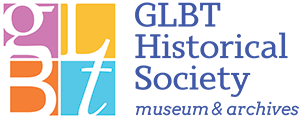The Birth of San Francisco Pride
A Manifestation of Courage & Celebration: The Birth of San Francisco Pride, 1970–1980
by Gerard Koskovich, Don Romesburg & Amy Sueyoshi
It all started with an impromptu march and a picnic. On June 27, 1970, a small band of hippies and “hair fairies” marched down Polk Street, then San Francisco’s most prominent LGBTQ area, to celebrate an event they called “Christopher Street Liberation Day.” The following afternoon, some 200 people congregated for a “Gay-In” picnic in Speedway Meadows at Golden Gate Park. These two modest gatherings inaugurated the annual celebration we now know as San Francisco Pride.
As difficult as it is to believe that every single Pride participant in 1970 could fit into a small area of the park, it’s also remarkable that just ten years later, Pride was drawing some 250,000 participants and spectators. The foundational first decade of Pride is the subject of a new online exhibition, “Labor of Love: The Birth of San Francisco Pride 1970–1980,” opening June 15 on the GLBT Historical Society’s website. It’s the second of two exhibitions the society is organizing to commemorate Pride’s golden jubilee.
“Labor of Love” is curated by three LGBTQ historians who have worked with the society for many years: Gerard Koskovich, Don Romesburg and Amy Sueyoshi. To introduce the exhibition, each selected one item that will be on display and wrote a brief reflection about its significance:
“Christopher Street Liberation Day Gay-In” offset flyer, June 1970; Charles Thorpe Papers (1987-02), GLBT Historical Society.
Gerard Koskovich: The flyer for the 1970 Christopher Street Liberation Day Gay-In is one of many items of ephemera that stand out for me. It’s our first fragile historical document recalling an event that appeared to have little impact at the time. At the end of the tumultuous 1960s, when enormous protests, sprawling counterculture festivals and massive full-on riots regularly dominated the news, a ragtag band of hippies and queens staging an informal march followed by a couple hundred queerfolk holding a picnic the next day didn’t strike much of anybody as meriting a headline.
The fact that this flyer survived likely tells us something important: Some of the people involved in the event thought of themselves as actors in history. In this case, the copy came to the archives with the papers of Charles Thorpe, an activist involved in the first glimmers of gay liberation in San Francisco. He carefully gathered this flyer and other materials documenting those efforts. For Thorpe, the flyer evidently wasn’t just designed to announce an event, then be tossed in the trash. It was a reminder of a manifestation of courage and celebration that should be handed along to the future.
San Francisco Gay Pride Program, 1972; San Francisco LGBT General Subjects Ephemera Collection (SUB EPH), folder “Pride (Lesbian and Gay Freedom Day, San Francisco) 1972–2010,” GLBT Historical Society.
Amy Sueyoshi: The logo for gay pride on the 1972 program features a raised fist with purple butterfly wings. It’s an odd image when you stare at it too long, but it reminds me of the explicit ties that the Gay Power movement had with other cultural nationalist movements such as Black Power. We know from Asian American activists that the alliances were far from perfect. Queers of color felt racism in dominantly white gay and lesbian spaces, and homophobia disabled full inclusion in the fight for Third World liberation. Still, the logo to me signals an aim for a liberation movement that explicitly articulates allyhood and intersectional identities, in its nod towards mariposa consciousness and a raised fist against white supremacy.
The Third World Gay Caucus contingent at the 1977 San Francisco Gay Freedom Day Parade; photograph by Marie Ueda, Marie Ueda Photographs (2006-12), GLBT Historical Society.
Don Romesburg: From its earliest years, people used Gay Freedom Day to express sameness and difference simultaneously. Unlike bars, organizations and neighborhoods, which served particular identitarian, political, cultural and erotic constituencies, the parade and festival were the only places where all of the community would experience its full collectivity. Yet many also used the gathering to assert the worth and pleasure of their particular facet of sexual and gender diversity. Gay Freedom Day became the annual reunion of one big queer dysfunctional family. Early Pride events showcased that we could all be an LGBTQ community, despite and through our differences.
That’s why I love this Marie Ueda photo of the Third World Gay Caucus, a coalitional organization for the liberation of queer people of color, marching in the 1977 parade. Black, Latinx and Asian American people assembled themselves under one banner, an exuberant solidarity in difference. And they gestured, through signs such as “Gay Rights Are Human Rights,” toward a universal call for all “gay” (what we’d now call LGBTQ) people to claim their full humanity in the face of racism, cis and hetero marginalization and erasure.
NOTE: “Labor of Love: The Birth of San Francisco Pride” opens here on June 15.
Gerard Koskovich is a San Francisco historian, curator, rare book dealer and a founding member of the GLBT Historical Society.
Don Romesburg is a professor of women’s and gender studies at Sonoma State University.
Amy Sueyoshi is dean of the College of Ethnic Studies at San Francisco State University.



